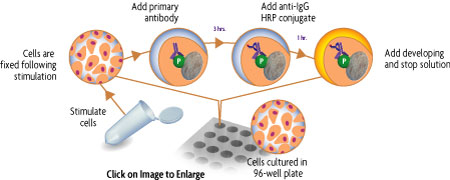THIS PRODUCT IS DISCONTINUED
Fast Activated Cell-based ELISA (FACE™) Kits provide a simple, sensitive method for detecting protein phosphorylation directly in the cell, without making extracts or performing electrophoresis and membrane blotting. These 96-well, high-throughput assays are available in both colorimetric and chemiluminescent formats for over 20 different targets (see list at right). For complete details, click the FACE™ Method tab below.
FACE AKT Kits provide 96 rxns each of 2 antibodies that enable you to monitor and compare the levels of both phosphorylated and total AKT. The phospho-AKT antibody recognizes AKT1 only when phosphorylated at Ser473, and AKT2 and AKT3 only when phosphorylated at equivalent sites; the total-AKT antibody recognizes AKT1, AKT2 and AKT3 regardless of the phosphorylation state. Click the AKT Info tab below for data and more information.
| Name | Format | Cat No. | Price | |
|---|---|---|---|---|
| FACE™ AKT | 1 x 96 rxns | 48120 | Discontinued | |
| 5 x 96 rxns | 48620 | Discontinued | ||
| FACE™ AKT Chemi | 1 x 96 rxns | 48220 | Discontinued | |
| 5 x 96 rxns | 48720 | Discontinued | ||
| FACE™ AKT Manual |
| FACE™ Profile |
| Cell Biology Products Brochure |
| IsoCyte™ Application Note – Phospho-Protein Detection |
| MSDS: Sodium Azide |
| MSDS: Sulphuric Acid |
| MSDS: Thimersol |

Figure 1: Measurement of phosphorylated and total AKT.NIH/3T3 cells were cultured in 96-well plates and serum-starved for 16 hours. Cells were then treated with 50 ng/ml PDGF for 5 minutes and fixed. Total and phospho-AKT were each assayed in triplicate using the phospho and total AKT antibodies from the FACE AKT Kit.
Antibody Specificities
The phospho-AKT antibody is specific for phosphorylated AKT and was raised against a phospho-Ser473 peptide that corresponds to the sequence surrounding Ser473 of mouse AKT. It recognizes AKT1 only when phosphorylated at Ser473, and AKT2 and AKT3 only when phosphorylated at equivalent sites. The total-AKT antibody recognizes AKT1, AKT2 and AKT3 regardless of the phosphorylation state.
AKT Overview
AKT, also known as protein kinase B (PKB) or Related to A and C kinases (RAC), is the cellular homolog of the viral oncogene v-AKT. It was originally cloned based on its homology to protein kinases A and C. AKT is activated in response to insulin, and various growth and survival factors. It is clear that AKT enzyme activity is both necessary and essential for cell survival, and AKT has been shown to be able to induce progression of the cell cycle as well as suppress apoptosis. The key role of AKT in the regulation of cell survival makes it a promising target for anti-oncogenic therapeutics.
The FACE™ Method
In FACE, cells are cultured in 96-well plates and stimulated to induce the pathway of interest. Following stimulation, the cells are fixed rapidly, which preserves activation-specific protein modifications. Each well is then incubated with a primary antibody specific for the activated protein of interest. Subsequent incubation with secondary HRP-conjugated antibody and developing solution provides a colorimetric or chemiluminescent readout that is quantitative and reproducible (Figure 1). The number of cells in each well can be normalized easily with the provided Crystal Violet solution. FACE Kits also contain primary antibody specific for the native inactive protein, so you can monitor both native and activated protein levels in the same experiment. FACE eliminates cellular extractions, radioactive kinase assays, time-consuming Westerns and inefficient epitope interactions that occur on membranes. FACE is a highly sensitive high-throughput assay designed for detecting activated proteins within mammalian cells.
Figure 1: Flow chart of the FACE process.
Flow chart of the FACE in cell Western method that uses a cell based ELISA to measure the levels of the native and phospho forms of signaling proteins and kinases that are activated by phosphorylation.
Contents & Storage
Two (or ten) 96-well plates for culturing cells, 96 (or 5 x 96) rxns each of two primary antibodies (1 phospho-specific, 1 specific for native protein), HRP-conjugated secondary antibody, Quenching Solution, 1X Antibody Blocking Buffer, 1X Antibody Dilution Buffer, 10X PBS, 10% Triton X-100, 1% SDS Solution, Developing and Stop Solutions, and Crystal Violet Cell Quantification Solution. Storage conditions vary from room temperature to -20°C, see manual for details. All reagents are guaranteed stable for 6 months when stored properly.


